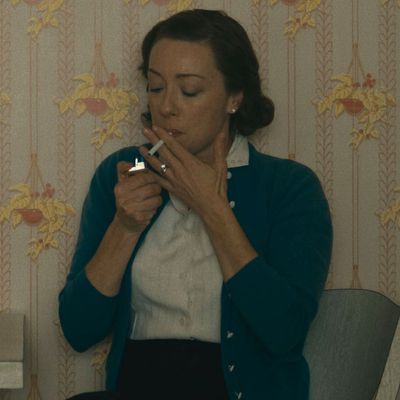
We’ve heard a lot about Hamlet over the course of Wormwood, so it’s only fitting that this story would eventually involve a gravedigger. The fourth episode, “Opening the Lid,” introduces us to Dr. James Starrs, forensic anthropologist and friend of the Olson family, who in 1994 offered to exhume Frank’s corpse and determine if it exhibited any signs of struggle or suicide. Starrs uncovers cuts and abrasions on the body, a sign of struggle, plus a large hematoma on his head pointing to some sort of injury before the fall. It’s pretty much exactly what Eric was looking to hear, and it’s what Morris needs to keep the true-crime component of his story alive.
The second autopsy is a macabre and yet deeply moving turn of events, best encapsulated in the moment Eric Olson recalls feeling the urge to touch part of his father’s newly unearthed skull (alas, poor Yorick). Wormwood is an investigation of a tragedy, but it’s also a highly personal matter, as Eric’s unresolved anguish at losing his father at the age of nine seems to have fueled almost every decision he’s made for the rest of his life. In Eric’s mind, digging up his father’s corpse, touching his decaying body, and remarking that he still had a visible penis isn’t just a totally normal, logical thing to do. It’s also an act of love.
The archival footage of Frank Olson’s body gives Morris a bit of a break from the reenactments, which he’s using to somewhat indiscriminate ends. Returning over and over to the hotel room, sometimes with more threatening men present, sometimes altering the interactions between all the key figures, it’s not clear if he’s testing out different versions of the same event, relaying different chapters of one timeline, or knowingly fantasizing about things that wouldn’t or couldn’t have happened. What is clear is that these splicings of fact and imagination are an attempt to replicate the “collage method,” Eric Olson’s Harvard doctoral thesis on how to help trauma survivors piece their minds back together. But collages are generally a bit more obvious in their presentation.
Morris has long known about the mysterious power of staged scenes in documentaries, the way they seem to impart an extra layer of authenticity by being deliberately inauthentic, and this isn’t the first time he’s experimented with their form. But it’d help to have a more thorough explanation of his aims here, especially if he’s going to interrogate Robert Lashbrook’s motives at the crucial moment of the story. Even to “leave the known universe,” as Eric Olson has said one needs to do in order to accept the possibility that the CIA would murder one of its own, surely requires that one keep some known quantities of investigations safely tucked away. If the whole thing is just a loopy trip with no answer, as Morris seems frequently on the verge of admitting, then all this teasing will only lead us further away from the truth.
This episode also gives more information about the CIA’s battle-tested assassination manual circa 1953, the year of Frank’s death, and declassified in 1997. The manual includes the very suspicious-looking (to Eric, anyway) piece of advice to “drop” targets from large heights and make it look like a suicide. Again, we get a case of dots seeming to connect very nicely, without a lot of hard evidence to back it up. Yet when the discussion turns to the matter of William Colby, former director of the CIA, we get a better sense of the real animating force behind this case: It’s not getting to the bottom of Frank’s death necessarily, but investigating the absolutist, reflexive nature of the CIA’s secret-keeping, the sense that nothing, ever, is worth revealing. We hear from a passage in Colby’s memoir where he expresses rare remorse at the way his agency treated the Olson family, while also professing ignorance to the specifics of what they had been informed and when.
So what is Colby’s true importance to the overall narrative? His 1996 drowning death is (surprise, surprise) still hotly debated in conspiracy circles, and Eric throws more fuel on the fire by noting its close proximity to the second autopsy and the Olson family’s efforts to reopen an investigation into Frank’s death. But surely the former director of the CIA would have a laundry list of people who’d want him dead? With a story as filled with odd details as this one, though, it would be folly to assume anything but the worst of any given situation.
Burning Questions and Notes
• Lashbrook’s phone call after Olson’s death, in its entirety: “He’s gone.” “That’s too bad.” Who’s on the other end?
• In order to void the earlier settlement agreement his family made with the CIA, Eric has to demonstrate they knowingly lied when they struck the deal for the public apology in 1975. But so far, we haven’t heard a thorough discussion of the available legal avenues, given the evidence they have.
• If you’re wondering why it would have been so easy to inspect Frank’s corpse for clues four decades after his death, Michael Ignatieff’s excellent 2001 article in the New York Times notes that Frank’s body had been embalmed unbeknownst to the family.

